
BIT NUMERICAL MATHEMATICS
Scope & Guideline
Catalyzing Breakthroughs in Mathematical Applications.
Introduction
Aims and Scopes
- Numerical Analysis and Algorithm Development:
The journal publishes research on new numerical methods, including convergence analysis, stability, and error estimation, aimed at solving ordinary and partial differential equations, integral equations, and other mathematical models. - Applied Mathematics and Computational Techniques:
Focus on applied numerical methods that cater to real-world problems, particularly in physics, engineering, and finance, utilizing computational techniques to derive practical solutions. - Interdisciplinary Approaches:
Encouragement of interdisciplinary research that combines numerical methods with other fields such as optimization, statistics, and machine learning, reflecting the evolving nature of applied mathematics. - Advanced Computational Techniques:
Research on innovative computational frameworks and tools, including high-performance computing, adaptive methods, and parallel algorithms, designed to tackle large-scale problems efficiently. - Theoretical Foundations and Mathematical Rigor:
Emphasis on the theoretical underpinnings of numerical methods, ensuring that the proposed algorithms are not only efficient but also grounded in solid mathematical principles.
Trending and Emerging
- Stochastic Differential Equations (SDEs):
An increasing number of papers focus on numerical methods for stochastic differential equations, reflecting the growing importance of uncertainty quantification and stochastic modeling in various applications. - Adaptive and High-Order Methods:
Emerging interest in adaptive algorithms and high-order numerical methods indicates a trend towards achieving greater accuracy and efficiency, particularly for complex and multi-dimensional problems. - Machine Learning and Data-Driven Approaches:
The integration of machine learning techniques with traditional numerical methods is on the rise, highlighting a shift towards data-driven approaches that leverage computational power to solve complex mathematical problems. - Multiscale and Multi-physics Problems:
Research addressing multiscale and multi-physics problems is becoming increasingly prevalent, as these topics are crucial for modeling complex systems in engineering, physics, and biology. - Robustness and Stability in Numerical Methods:
There is a growing emphasis on developing robust numerical methods that maintain stability under various conditions, catering to the demands of real-world applications where uncertainties and variabilities are common.
Declining or Waning
- Classical Numerical Methods:
Traditional numerical methods, such as basic finite difference and finite element techniques, are appearing less frequently as the field shifts towards more sophisticated and adaptive approaches that address complex problems. - Single-Domain Approaches:
Research focusing solely on single-domain numerical methods is declining in favor of multi-domain and domain decomposition techniques, which offer better performance for complex geometries and multi-scale problems. - Numerical Methods with Limited Applications:
There is a noticeable reduction in publications focused on numerical methods that cater to niche applications, as researchers increasingly seek broader applicability and interdisciplinary relevance in their work.
Similar Journals
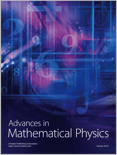
Advances in Mathematical Physics
Exploring the Boundaries of Mathematics and PhysicsAdvances in Mathematical Physics is a premier open-access journal published by HINDAWI LTD, dedicated to the dissemination of research in the fields of applied mathematics and physics. With its ISSN 1687-9120 and E-ISSN 1687-9139, this journal has been a vital platform for innovative studies since its inception in 2009, fostering a collaborative environment for researchers and professionals alike. The journal features a wide range of topics, including but not limited to mathematical models, computational physics, and interdisciplinary applications, thus attracting a diverse readership. Ranked in the Q3 quartile for both Applied Mathematics and Physics and Astronomy, it serves as a significant resource for academics looking to explore cutting-edge developments and theoretical advancements. With an emphasis on open accessibility, Advances in Mathematical Physics ensures that research findings are readily available to the global academic community, leveling the playing field for emerging scholars and seasoned researchers. By consistently showcasing high-quality manuscripts, the journal contributes substantially to the fields of mathematics and physics, encouraging scholarly dialogue and advancing knowledge across a myriad of applications.
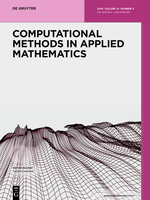
Computational Methods in Applied Mathematics
Unveiling Insights in Numerical AnalysisComputational Methods in Applied Mathematics is a premier academic journal published by WALTER DE GRUYTER GMBH, based in Germany. With its ISSN 1609-4840 and E-ISSN 1609-9389, this journal serves as a crucial platform for the dissemination of cutting-edge research and innovations in the fields of Applied Mathematics, Computational Mathematics, and Numerical Analysis. Notably, it has been recognized in 2023 with a Q2 ranking in its category quartiles, marking it as a significant contributor in its discipline. Spanning from 2001 to 2024, it fosters interdisciplinary collaboration and exploration of computational methodologies that solve complex mathematical problems. Though it operates on a traditional access model, its relevance is underscored by its Scopus rankings, which place it among the notable leaders in its area. As a trusted source of scholarly articles, Computational Methods in Applied Mathematics is an essential resource for researchers, professionals, and students aiming to stay abreast of advancements and discussions that shape the future of applied mathematics.
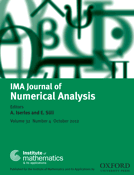
IMA JOURNAL OF NUMERICAL ANALYSIS
Advancing the Frontiers of Numerical MethodsIMA Journal of Numerical Analysis, published by Oxford University Press, stands as a premier platform for cutting-edge research in the field of numerical analysis, exemplifying the latest advancements and methodologies in applied, computational, and general mathematics. Since its inception in 1981, this esteemed journal has continually contributed to the academic community by publishing high-quality, peer-reviewed articles that foster innovation and collaboration among researchers. With an impressive Q1 ranking across multiple categories, including Applied Mathematics and Computational Mathematics, it plays a crucial role in disseminating knowledge, as indicated by its Scopus rankings which place it in the top 25% of journals within its field. Although the journal is not open access, it remains a vital resource for academics, professionals, and students eager to engage with the ongoing evolution of numerical methods. By serving as a conduit for novel ideas and rigorous research, the IMA Journal of Numerical Analysis ensures that its contributors and readers are at the forefront of this dynamic discipline.

Frontiers of Mathematics
Pioneering Ideas in the World of Mathematical ResearchFrontiers of Mathematics, published by SPRINGER HEIDELBERG, is an emerging academic journal dedicated to fostering the advancement of mathematical sciences from 2023 to 2024. With an ISSN of 2731-8648 and E-ISSN of 2731-8656, this journal is positioned in the category of Q2 in the miscellaneous mathematics domain, showcasing its commitment to quality research and innovation. Although in its nascent stages, it has swiftly established a foothold within the global academic landscape, holding a Scopus rank of #198/399 and a median percentile of 50, indicating a promising trajectory. By providing an open-access option, Frontiers of Mathematics ensures broad dissemination of research findings, fostering collaboration and knowledge sharing across the mathematical community. Researchers, professionals, and students alike will find this journal to be an invaluable resource, contributing to important discussions and advancements in various mathematical fields.

TWMS Journal of Applied and Engineering Mathematics
Exploring Practical Solutions in Applied MathematicsTWMS Journal of Applied and Engineering Mathematics, published by TURKIC WORLD MATHEMATICAL SOC, is a distinguished open-access journal that has been contributing to the field of applied mathematics since 2011. With a focus on theoretical and practical applications spanning various areas including Computational Mathematics, Control and Optimization, and Numerical Analysis, this journal serves as a vital resource for researchers and professionals looking to disseminate and access quality research. Although currently positioned in the Q4 quartile across several mathematical categories in 2023, the journal aims to provide a platform for innovative research, fostering collaboration and knowledge sharing among scholars worldwide. Located in Turkey, this journal emphasizes accessible content, inviting a diverse audience to explore breakthroughs and advancements in mathematical sciences. With its broad spectrum of topics, TWMS Journal not only enriches academic discourse but also plays a crucial role in supporting the development of new methodologies and technologies in engineering and applied mathematics.

JOURNAL OF SCIENTIFIC COMPUTING
Transforming Theoretical Concepts into Practical ApplicationsJOURNAL OF SCIENTIFIC COMPUTING, published by Springer/Plenum Publishers, stands as a premier venue for disseminating innovative research in the domains of applied mathematics, computational mathematics, and numerical analysis, among others. With an illustrious history spanning from 1986 to 2024, this journal has established itself as a vital resource for scholars and practitioners, reflected in its Q1 status in multiple categories including Applied Mathematics and Software, as per the 2023 rankings. The journal features a rigorous peer-review process, ensuring high-quality publications that contribute to the advancement of theoretical and practical knowledge in scientific computing. Although not open access, the journal provides critical insights and methodologies that are invaluable for advancing computational techniques in engineering and mathematics. With impressive Scopus rankings, including being in the 78th percentile for Numerical Analysis, JOURNAL OF SCIENTIFIC COMPUTING is essential reading for researchers, professionals, and students aiming to stay at the forefront of scientific innovation.

Numerical Analysis and Applications
Empowering researchers with vital insights in numerical techniques.Numerical Analysis and Applications is a prominent journal dedicated to advancing the field of numerical analysis, published by the Siberian Branch of the Russian Academy of Sciences. Established in 2009, and running through to 2024, this scholarly publication serves as a vital resource for researchers, professionals, and students involved in the mathematical sciences. The journal’s impact is underscored by its classification in the Q3 quartile for numerical analysis within the latest metrics, reflecting its significance in the academic community, although it presently ranks 74 out of 88 in the numerical analysis category, representing a 16th percentile. With a broad scope that encompasses innovative methodologies and applications in numerical techniques, the journal aims to foster interdisciplinary collaboration and share pivotal advancements in numerical theory and practice. Access options may vary, thus offering opportunities for both traditional and contemporary researchers to engage with cutting-edge content that is crucial for driving forward the computational sciences.

Italian Journal of Pure and Applied Mathematics
Bridging Theory and Application in MathematicsThe Italian Journal of Pure and Applied Mathematics, published by FORUM EDITRICE UNIV UDINESE, is an esteemed platform dedicated to the dissemination of high-quality research within the field of mathematics. With an ISSN of 1126-8042 and an E-ISSN of 2239-0227, this journal serves as a crucial resource for mathematicians seeking to contribute to current discussions and advancements in both pure and applied mathematical sciences. Although the journal currently holds a quartile rank of Q4 in the field of miscellaneous mathematics and is positioned within the 10th percentile of Scopus rankings, it remains committed to fostering valuable academic discourse. This journal particularly welcomes submissions that explore innovative mathematical theories and methodologies, offering a unique insight into the diverse aspects of mathematical research. Operating under a traditional access model, it provides a gateway for researchers, professionals, and students to deepen their understanding and expand their contributions to the mathematical community. With coverage spanning from 2010 to 2024, the journal continues to enhance its reputation as a reliable source of contemporary mathematical scholarship.
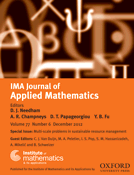
IMA JOURNAL OF APPLIED MATHEMATICS
Empowering Researchers with Rigorous Mathematical InsightsThe IMA Journal of Applied Mathematics, published by Oxford University Press, serves as a pivotal platform for disseminating innovative research in the field of applied mathematics. With its ISSN 0272-4960 and E-ISSN 1464-3634, the journal has established itself as an essential resource for academics and practitioners, showing notable engagement with both theoretical and practical aspects of mathematics. Spanning over five decades since its inception in 1965, the journal covers a broad range of topics aimed at addressing complex real-world problems through mathematical modeling and computational techniques. Holding a Q3 quartile ranking in the applied mathematics category for 2023, and a Scopus rank of #310 out of 635, it plays a significant role in contributing to the academic discourse within this dynamic field. Despite not being open access, the journal's robust reputation and commitment to rigorous peer review ensure that cutting-edge research remains accessible to its audience of researchers, professionals, and students dedicated to advancing mathematical sciences. Its ongoing commitment to exceptional scholarship makes the IMA Journal of Applied Mathematics a vital resource for those seeking to explore and apply mathematical principles in various contexts.
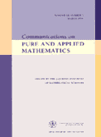
COMMUNICATIONS ON PURE AND APPLIED MATHEMATICS
Elevating Mathematical Discourse for Tomorrow's ChallengesCommunications on Pure and Applied Mathematics, published by Wiley, is a prestigious journal in the field of mathematics, recognized for its rigorous exploration of both theoretical and applied mathematical concepts. With an ISSN of 0010-3640 and an E-ISSN of 1097-0312, this journal has been a cornerstone of mathematical research since its inception in 1948 and will continue to serve the academic community until 2024. Ranked in the Q1 category for both Applied Mathematics and Miscellaneous Mathematics in 2023, it holds a commendable position among its peers, as evidenced by its Scopus rankings—#9 out of 399 for General Mathematics, placing it in the 97th percentile, and #55 out of 635 for Applied Mathematics, at the 91st percentile. The journal promotes the dissemination of high-quality research and fosters advancements in the mathematical sciences, making it an invaluable resource for researchers, professionals, and students alike, who are eager to stay at the forefront of mathematical innovation and application.